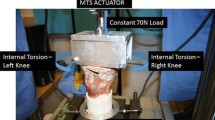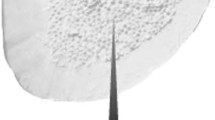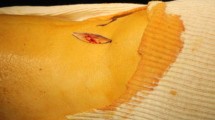Abstract
We investigated if injectable calcium phosphate cement improves primary stability in open-wedge high-tibial osteotomy. A 10 mm open-wedge osteotomy was performed on eight pairs of preserved cadaver tibiae and seven pairs of composite (Sawbone) left tibiae. Osteosynthesis was performed with the Dynafix plate system. The gap resulting from surgery either was filled with 15 g injectable calcium phosphate cement in half the bones or was left untreated. The composite tibiae were loaded at a ramp speed of 20 mm/min up to 20 kN. The cadaver tibiae were exposed to 100 cycles with a maximum compressive force of 2,250 N. After 100 cycles of loading with 2,250 N, the final loaded displacement was 1.2 mm for the cadaver tibiae treated with injectable calcium phosphate cement as compared with 3.6 mm for the empty defects (P = 0.028). All the seven empty defect composite specimens failed prior to 20 kN (median 2.8 kN) as compared with five of the injectable calcium phosphate cement specimens (median 17 kN) (P = 0.005). The injection of injectable calcium phosphate cement following open-wedge osteotomy of the proximal tibia increases the initial stability of the bone as measured by load-to-failure and displacement after cyclic loading. Clinical studies are ongoing to investigate whether injectable calcium phosphate cement also has clinical advantage on wedge healing and stability.





Similar content being viewed by others
References
Agneskirchner JD, Freiling D, Hurschler C, Lobenhoffer P (2006) Primary stability of four different implants for opening wedge high tibial osteotomy. Knee Surg Sports Traumatol Arthrosc 14:291–300
Augat P, Burger J, Schorlemmer S, Henke T, Peraus M, Claes L (2003) Shear movement at the fracture site delays healing in a diaphyseal fracture model. J Orthop Res 21:1011–1017
Baas J (2008) Adjuvant therapies of bone graft around non-cemented experimental orthopedic implants stereological methods and experiments in dogs. Acta Orthop Suppl 79:1–43
Claes L, Augat P, Suger G, Wilke HJ (1997) Influence of size and stability of the osteotomy gap on the success of fracture healing. J Orthop Res 15:577–584
Claes LE, Heigele CA (1999) Magnitudes of local stress and strain along bony surfaces predict the course and type of fracture healing. J Biomech 32:255–266
Cristofolini L, Viceconti M (2000) Mechanical validation of whole bone composite tibia models. J Biomech 33:279–288
Devgan A, Marya KM, Kundu ZS, Sangwan SS, Siwach RC (2003) Medial opening wedge high tibial osteotomy for osteoarthritis of knee: long-term results in 50 knees. Med J Malaysia 58:62–68
Dorsey WO, Miller BS, Tadje JP, Bryant CR (2006) The stability of three commercially available implants used in medial opening wedge high tibial osteotomy. J Knee Surg 19:95–98
Dugdale TW, Noyes FR, Styer D (1992) Preoperative planning for high tibial osteotomy. The effect of lateral tibiofemoral separation and tibiofemoral length. Clin Orthop Relat Res 24:8–264
Frankenburg EP, Goldstein SA, Bauer TW, Harris SA, Poser RD (1998) Biomechanical and histological evaluation of a calcium phosphate cement. J Bone Joint Surg Am 80:1112–1124
Fujisawa Y, Masuhara K, Shiomi S (1979) The effect of high tibial osteotomy on osteoarthritis of the knee. An arthroscopic study of 54 knee joints. Orthop Clin North Am 10:585–608
Gaasbeek RD, Toonen HG, van Heerwaarden RJ, Buma P (2005) Mechanism of bone incorporation of beta-TCP bone substitute in open wedge tibial osteotomy in patients. Biomaterials 26:6713–6719
Greenwald AS, Boden SD, Goldberg VM, Khan Y, Laurencin CT, Rosier RN (2001) Bone-graft substitutes: facts, fictions, and applications. J Bone Joint Surg Am 83-A(Suppl 2 Pt 2):98–103
Hernigou P, Ma W (2001) Open wedge tibial osteotomy with acrylic bone cement as bone substitute. Knee 8:103–110
Hernigou P, Medevielle D, Debeyre J, Goutallier D (1987) Proximal tibial osteotomy for osteoarthritis with varus deformity. A ten to thirteen-year follow-up study. J Bone Joint Surg Am 69:332–354
Horstmann WG, Verheyen CC, Leemans R (2003) An injectable calcium phosphate cement as a bone-graft substitute in the treatment of displaced lateral tibial plateau fractures. Injury 34:141–144
Khairoun I, Boltong MG, Driessens FC, Planell JA (1997) Effect of calcium carbonate on clinical compliance of apatitic calcium phosphate bone cement. J Biomed Mater Res 38:356–360
Koshino T, Murase T, Saito T (2003) Medial opening-wedge high tibial osteotomy with use of porous hydroxyapatite to treat medial compartment osteoarthritis of the knee. J Bone Joint Surg Am 85-A:78–85
Koshino T, Murase T, Takagi T, Saito T (2001) New bone formation around porous hydroxyapatite wedge implanted in opening wedge high tibial osteotomy in patients with osteoarthritis. Biomaterials 22:1579–1582
Linde F, Hvid I, Jensen NC (1985) Material properties of cancellous bone in repetitive axial loading. Eng Med 14:173–177
Lobenhoffer P, Agneskirchner JD (2003) Improvements in surgical technique of valgus high tibial osteotomy. Knee Surg Sports Traumatol Arthrosc 11:132–138
Lobenhoffer P, Gerich T, Witte F, Tscherne H (2002) Use of an injectable calcium phosphate bone cement in the treatment of tibial plateau fractures: a prospective study of twenty-six cases with twenty-month mean follow-up. J Orthop Trauma 16:143–149
Magyar G (1999) Osteotomy for gonarthrosis, Thesis, Lund
Miller BS, Dorsey WO, Bryant CR, Austin JC (2005) The effect of lateral cortex disruption and repair on the stability of the medial opening wedge high tibial osteotomy. Am J Sports Med 33:1552–1557
Ooms EM, Wolke JG, van de Heuvel MT, Jeschke B, Jansen JA (2003) Histological evaluation of the bone response to calcium phosphate cement implanted in cortical bone. Biomaterials 24:989–1000
Ooms EM, Wolke JG, van der Waerden JP, Jansen JA (2002) Trabecular bone response to injectable calcium phosphate (Ca-P) cement. J Biomed Mater Res 61:9–18
Pagnano MW, Clarke HD, Jacofsky DJ, Amendola A, Repicci JA (2005) Surgical treatment of the middle-aged patient with arthritic knees. Instr Course Lect 54:251–259
Russell JL, Block JE (2000) Surgical harvesting of bone graft from the ilium: point of view. Med Hypotheses 55:474–479
Spahn G, Wittig R (2002) Primary stability of various implants in tibial opening wedge osteotomy: a biomechanical study. J Orthop Sci 7:683–687
Staubli AE, De SC, Babst R, Lobenhoffer P (2003) TomoFix: a new LCP-concept for open wedge osteotomy of the medial proximal tibia—early results in 92 cases. Injury 34(Suppl 2):55–62
Stoffel K, Stachowiak G, Kuster M (2004) Open wedge high tibial osteotomy: biomechanical investigation of the modified Arthrex Osteotomy Plate (Puddu Plate) and the TomoFix Plate. Clin Biomech (Bristol, Avon) 19:944–950
Stuart MJ, Beachy AM, Grabowski JJ, An KN, Kaufman KR (1999) Biomechanical evaluation of a proximal tibial opening-wedge osteotomy plate. Am J Knee Surg 12:148–153
Taylor WR, Heller MO, Bergmann G, Duda GN (2004) Tibio-femoral loading during human gait and stair climbing. J Orthop Res 22:625–632
Welch RD, Zhang H, Bronson DG (2003) Experimental tibial plateau fractures augmented with calcium phosphate cement or autologous bone graft. J Bone Joint Surg Am 85-A:222–231
Wright JM, Crockett HC, Slawski DP, Madsen MW, Windsor RE (2005) High tibial osteotomy. J Am Acad Orthop Surg 13:279–289
Yetkinler DN, McClellan RT, Reindel ES, Carter D, Poser RD (2001) Biomechanical comparison of conventional open reduction and internal fixation versus calcium phosphate cement fixation of a central depressed tibial plateau fracture. J Orthop Trauma 15:197–206
Zhim F, Laflamme GY, Viens H, Laflamme GH, Yahia L (2006) Biomechanical stability of a retrotubercle opening-wedge high tibial osteotomy. J Knee Surg 19:28–32
Acknowledgments
The authors wish to thank: The Program of Body Donation to Medical Science, Institute of Anatomy, Aarhus University. The study was financially supported by the following non-commercial institutions: WSF, Western Denmark Health Research grant of Aarhus University, Danish Rheumatism Association, The Opel Family Foundation, The Spar Nord Foundation. The study have benefited from institutional research support from the following company with commercial interests in this research area: Biomet Denmark
Author information
Authors and Affiliations
Corresponding author
Rights and permissions
About this article
Cite this article
Lind-Hansen, T., Nielsen, P.T., Petruskevicius, J. et al. Calcium phosphate cement enhances primary stability of open-wedge high-tibial osteotomies. Knee Surg Sports Traumatol Arthrosc 17, 1425–1432 (2009). https://doi.org/10.1007/s00167-009-0862-5
Received:
Accepted:
Published:
Issue Date:
DOI: https://doi.org/10.1007/s00167-009-0862-5




